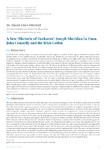A New Rhetoric of Darkness: Joseph Sheridan Le Fanu, John Connolly and the Irish Gothic

Use este enlace para citar
http://hdl.handle.net/2183/25963Colecciones
- Investigación (FFIL) [816]
Metadatos
Mostrar el registro completo del ítemTítulo
A New Rhetoric of Darkness: Joseph Sheridan Le Fanu, John Connolly and the Irish GothicAutor(es)
Fecha
2020Cita bibliográfica
Clark Mitchell, D. (2020). A New ‘Rhetoric of Darkness’: Joseph Sheridan Le Fanu, John Connolly and the Irish Gothic. Oceánide, 13, 95-102.
Resumen
[Abstract] The relationship between Ireland and the Gothic goes back to the early days of the genre, when the Sublime, as identified by the Irish philosopher Edmund Burke, became central to the aesthetic concepts which would abound in the articulation of the Gothic as a literary form. The “dark, desolate and stormy grandeur” of the perception of Ireland which was held by the English reading public in the late eighteenth century was readily adaptable for the use of the island as a kind of pre-Enlightenment wilderness which, when combined with its linguistic, religious and cultural “otherness”, provided a fertile territory for the growth of a literature which favoured the supernatural, the uncanny and the numerous features which unite to make up the genre. As early as 1771, Elizabeth Griffin’s The History of Lady Barton contains elements of the Gothic, and the huge popularity of Waterford-born Regina Maria Roche’s The Children of the Abbeygave a definitive boost to the genre with regard to Irish writers. The success of Sydney Owenson’s The Wild Irish Girl, and that of Charles Robert Maturin with The Milesian Chief and Melmoth the Wanderer helped foster a tradition which would be continued throughout the nineteenth century by writers such as Joseph Sheridan Le Fanu, L.T. Meade and Bram Stoker. It is Le Fanu who, arguably, was the first writer to merge the Gothic with crime fiction. For Begnall, his works “oscillate between the poles of supernatural horror and suspenseful detection”, and, in short fiction such as “The Murdered Cousin” and “The Evil Guest” and novels including Uncle Silas and Wylder’s HandLe Fanu consciously merges the emerging format of the murder mystery with the lugubrious labyrinths of the Gothic. Le Fanu’s influence was, of course, international, but the paths he trod were also followed by numerous Irish writers. One of the most successful of these is John Connolly who, since the introduction of Charlie Parker with the publication of Every Dead Thing in 1999 has, in the eighteen novels which have appeared to date, successfully revised the concepts and tropes which make up the Irish Gothic. In this paper these works will be analysed with reference to their debt to the Irish Gothic tradition and, most specifically, to the writing of Le Fanu. [Resumen] La relación entre Irlanda y el gótico se remonta a los primeros días del género, cuando lo Sublime, según lo identificó el filósofo irlandés Edmund Burke, se hizo fundamental para los conceptos estéticos que abundarían en la articulación del gótico como forma literaria. La “grandeza oscura, desolada y tormentosa” de la percepción de Irlanda que el público lector inglés tenía a fines del siglo XVIII era fácilmente adaptable a la utilización de la isla como una especie de tierra salvaje pre- Ilustración que, al combinarse con su “otredad” lingüística, religiosa y cultural, produjo un territorio fértil para el crecimiento de una literatura que favorecía lo sobrenatural, lo extraño y las demás características que forman el género. Ya en 1771, The History of Lady Barton, de Elizabeth Griffin, contiene elementos del gótico, y la gran popularidad de The Children of the Abbey, de Regina Maria Roche, nacida en Waterford, le dio un impulso definitivo al género en lo que respecta a los escritores irlandeses. El éxito de The Wild Irish Girl, de Sydney Owenson, y el de Charles Robert Maturin con The Milesian Chief y Melmoth the Wanderer ayudaron a fomentar una tradición que continuaría durante todo el siglo XIX con escritores como Joseph Sheridan Le Fanu, L.T. Meade y Bram Stoker. Es Le Fanu quien, posiblemente, fue el primer escritor en fusionar el gótico con la ficción detectivesca. Para Begnall, sus obras “oscillate between the poles of supernatural horror and suspenseful detection” y, en la narrativa breve, como “The Murdered Cousin” y “The Evil Guest” y en novelas como Uncle Silas y Wylder’s Hand, Le Fanu fusiona conscientemente el incipiente formato de la novela de misterio con los lúgubres laberintos del gótico. La influencia de Le Fanu fue, por supuesto, internacional, pero los caminos que recorrió fueron seguidos por numerosos escritores irlandeses. Uno de los más conocidos es John Connolly quien, desde la introducción de Charlie Parker con la publicación de Every Dead Thing en 1999, en las dieciocho novelas que han aparecido hasta la fecha, revisó con éxito los conceptos y tropos que componen el gótico irlandés. En este artículo, estos trabajos serán analizados con referencia a su deuda con la tradición gótica irlandesa y, más específicamente, con la escritura de Le Fanu.
Palabras clave
Gothic
Irish literature
Crime fiction
Le Fanu; Joseph Sheridan
Connolly, John
Gótico
Literatura irlandesa
Novela negra
Irish literature
Crime fiction
Le Fanu; Joseph Sheridan
Connolly, John
Gótico
Literatura irlandesa
Novela negra
Versión del editor
Derechos
Atribución 4.0
ISSN
1989-6328






